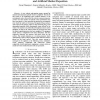395 search results - page 5 / 79 » Sensor localization in concave environments |
SASN
2006
ACM
14 years 1 months ago
2006
ACM
Wireless sensor networks are typically deployed to measure the information field, rather than create an information field. However, by utilizing the radio on sensor nodes, it is...
ICNSC
2007
IEEE
14 years 1 months ago
2007
IEEE
— A new velocity and position sensor concept for manned and unmanned ground vehicles is proposed. The idea of this system is to temporarily place artificial markers in the enviro...
HCI
2007
13 years 9 months ago
2007
This paper explores how a ‘learning’ algorithm can be added to UGV’s by giving it the ability to test the terrain through ‘feeling’ using incorporated sensors, which woul...
TROB
2008
13 years 7 months ago
2008
Abstract--Cooperating mobile sensors can be used to model environmental functions such as the temperature or salinity of a region of ocean. In this paper, we adopt an optimal filte...
IJRR
2011
13 years 2 months ago
2011
Visual and inertial sensors, in combination, are able to provide accurate motion estimates and are well-suited for use in many robot navigation tasks. However, correct data fusion...

